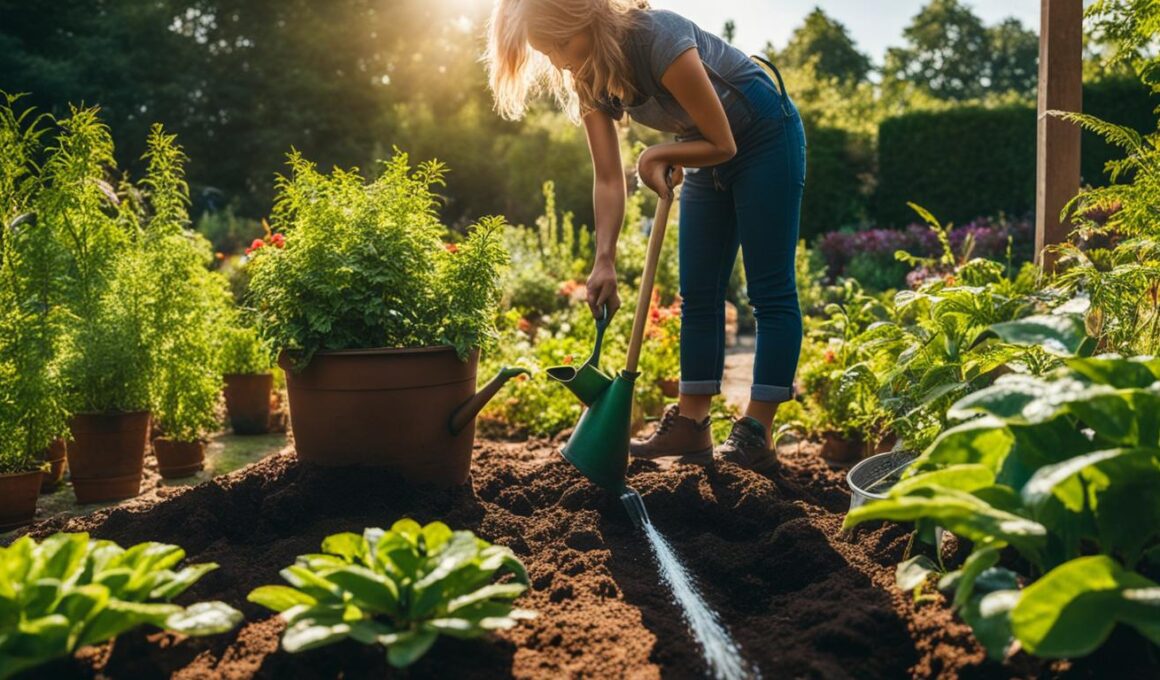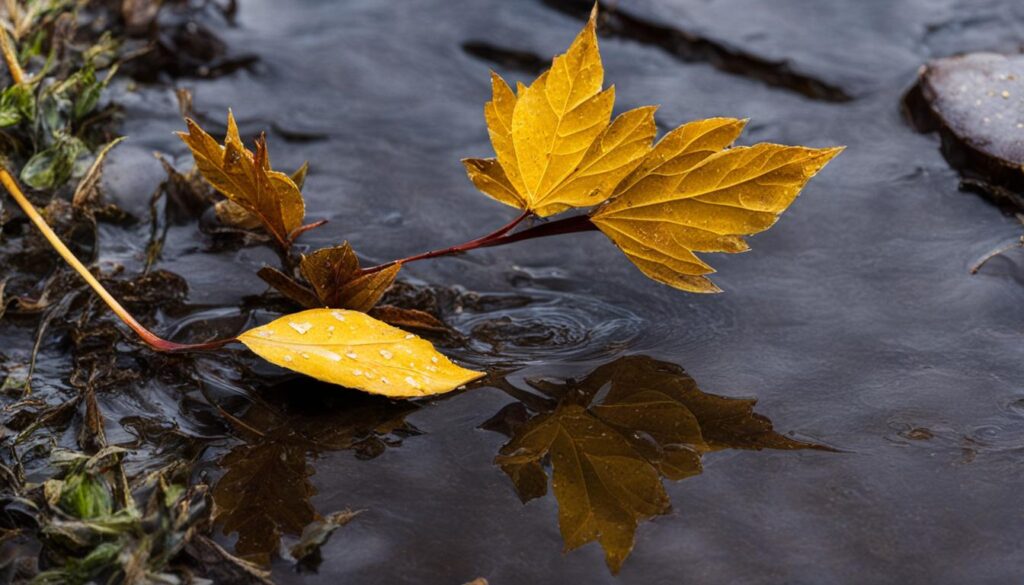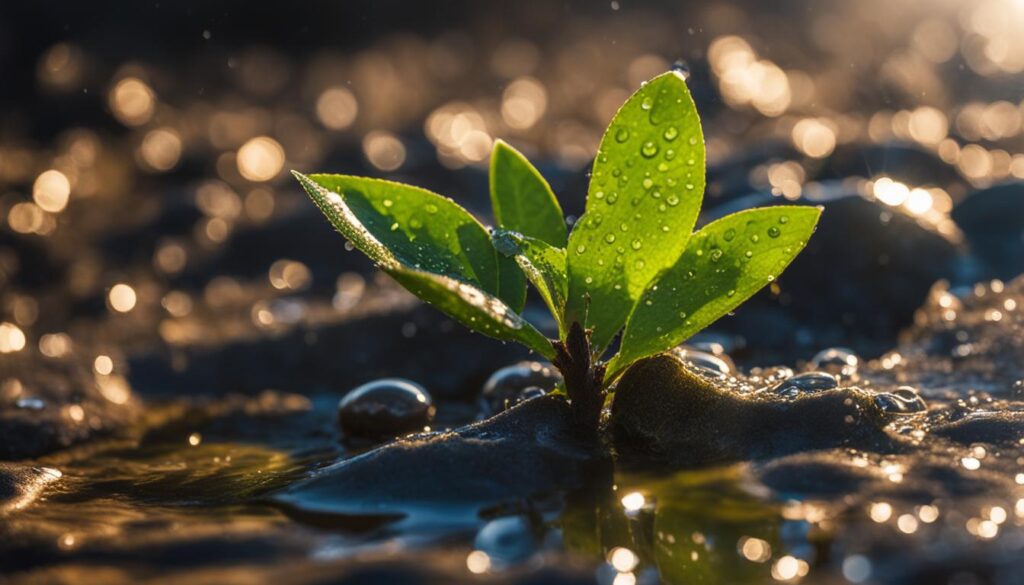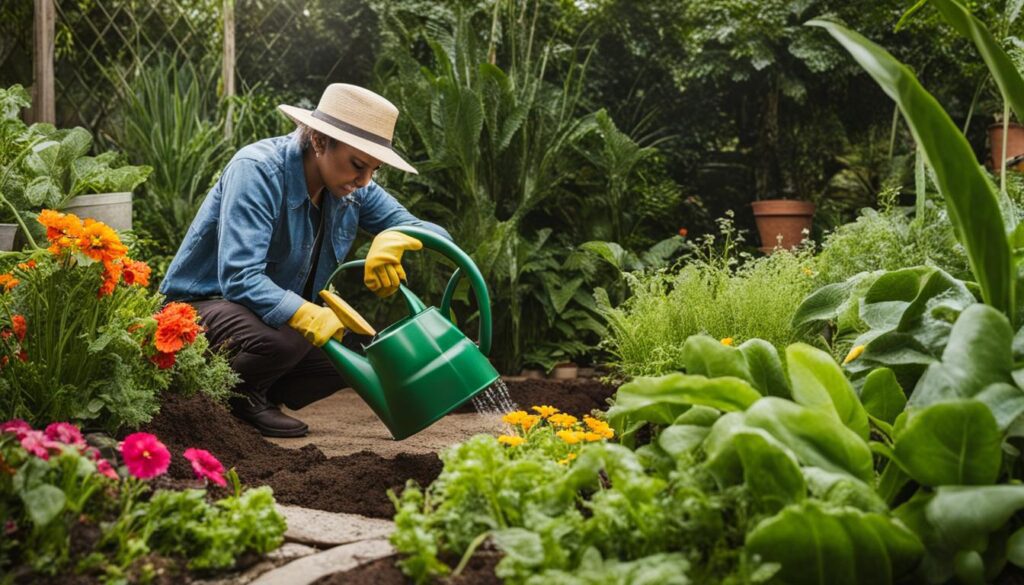Are your outdoor plants suffering from overwatering? Don’t worry, you can revive them and bring them back to life. Overwatering can suffocate the roots and harm the plants, but with a few simple steps, you can fix the damage and help your plants thrive once again.
Key Takeaways:
- Recognize the signs of overwatering, such as yellowing or browning leaves, wilting, and green soil.
- Stop watering the plant and allow the soil to dry out completely.
- Consider repotting the plant with improved soil and moving it to a shaded spot.
- Increase air flow around the plant to aid in drying out the soil and roots.
- Monitor the plant closely during the recovery process and adjust the watering schedule to prevent future overwatering.
By following these simple steps, you can fix overwatered outdoor plants and help them recover. Remember to pay attention to the signs, give your plants the care they need, and prevent overwatering in the future.
Signs of Overwatering Outdoor Plants
Overwatering can have detrimental effects on outdoor plants, and it is crucial to recognize the signs of overwatering to take appropriate action. By identifying these signs early on, you can prevent further damage to your plants and promote their recovery.
One of the most common signs of overwatering is the yellowing or browning of leaves. Excessive moisture can cause the roots to suffocate, leading to the discoloration of leaves. Wilting is another indicator of overwatering, as the roots are unable to absorb oxygen properly. Additionally, the soil may appear green due to algae growth, which can thrive in consistently moist conditions. It is important to note that these signs may vary depending on the specific plant species.
To accurately determine if your outdoor plants have been overwatered, it is essential to check the moisture levels in the soil. While the surface of the soil may appear dry, the underlying layers could be waterlogged. To assess the moisture content, you can use a soil moisture meter, which provides an instant reading. This tool enables you to make informed decisions about watering and prevent overwatering in the future.
Common Signs of Overwatering:
- Yellowing or browning leaves
- Wilting
- Green soil due to algae growth
“Overwatering is a common mistake that can harm your outdoor plants. By understanding and recognizing the signs of overwatering, you can take the necessary steps to save your plants and promote their healthy growth.”
It is essential to address overwatering promptly to prevent further damage to your outdoor plants. By identifying the signs of overwatering and monitoring soil moisture levels, you can ensure the proper care and recovery of your plants. In the next section, we will discuss the steps to fix overwatered outdoor plants and help them regain their vitality.
Steps to Fix Overwatered Outdoor Plants
If you’ve discovered that your outdoor plants have been overwatered, it’s essential to take prompt action to save them. Here are the steps you can follow to fix and revive overwatered plants:
- Stop watering the plant: The first step is to immediately stop watering the plant. Continuing to water it will only worsen the situation and lead to root rot.
- Allow the soil to dry out: Give the plant some time to dry out completely. This can take anywhere from a few days to a week, depending on the severity of overwatering and environmental conditions.
- Consider repotting: If the soil is still too wet after a few days, you may need to repot the plant. Choose a new pot with proper drainage holes and use a well-draining potting mix to ensure adequate airflow to the roots.
- Move the plant to a shaded spot: Excessive sunlight can further stress overwatered plants. Find a shaded location where the plant can receive indirect light and allow it to recover.
- Increase air flow: Improving air circulation can help speed up the drying process. You can use a fan or place the plant in an area with good air movement to aid in evaporation.
By following these steps, you can give your overwatered outdoor plants the best chance of recovery. It’s important to be patient during this process and closely monitor the plant’s progress. Adjust your watering schedule accordingly to prevent future overwatering and promote healthy growth.
| Step | Description |
|---|---|
| Stop watering the plant | Halting further water intake to prevent root rot |
| Allow the soil to dry out | Give the plant time to dry completely, typically a few days to a week |
| Consider repotting | Use a new pot with drainage holes and well-draining soil to improve root health |
| Move the plant to a shaded spot | Protect the plant from excessive sunlight that can further stress it |
| Increase air flow | Improve air circulation with a fan or placing in a well-ventilated area |
How Long Does it Take for Overwatered Plants to Recover?
After you have taken the necessary steps to fix an overwatered outdoor plant, you may be wondering how long it will take for the plant to recover. The recovery time can vary depending on several factors, including the extent of overwatering, the type of plant, and the environmental conditions.
On average, it can take between one and two weeks for an overwatered plant to dry out and start the recovery process. During this time, it is important to closely monitor the plant and adjust the watering schedule accordingly to prevent future overwatering. By allowing the soil to completely dry out and the roots to recover from the excess moisture, the plant will have a better chance of bouncing back.
It is worth noting that some plants may take longer to recover than others. For example, plants with shallow root systems or those that are more sensitive to overwatering may require a longer recovery period. Additionally, if the overwatering was severe and caused significant damage to the roots, it may take even longer for the plant to fully recover.
Factors Affecting Recovery Time
Several factors can influence the recovery time of overwatered plants:
- The extent of overwatering: The duration and severity of overwatering will impact how long it takes for the plant to recover.
- Type of plant: Different plants have varying tolerances and abilities to recover from overwatering. Some plants are more resilient and can bounce back quicker, while others may take longer.
- Environmental conditions: Factors such as temperature, humidity, and sunlight can affect the plant’s ability to recover. Warmer temperatures and higher humidity levels can slow down the drying process.
Monitoring and Patience
During the recovery period, it is essential to closely monitor the plant’s progress. Check the soil moisture levels regularly and only water the plant when the soil is dry to the touch. Avoid the temptation to overcompensate for the previous overwatering by excessive watering.
Quote: “Patience is key when it comes to helping an overwatered plant recover. Rushing the process can do more harm than good. Give the plant time to heal and revive naturally.”
By practicing patience and providing the necessary care, your overwatered outdoor plants will eventually recover and thrive once again.
| Factors Affecting Recovery Time | Average Recovery Time |
|---|---|
| Extent of overwatering | 1-2 weeks |
| Type of plant | Varies |
| Environmental conditions | Can prolong recovery time |
Preventing Overwatering in Outdoor Plants
Proper watering is crucial for the health and vitality of outdoor plants. To prevent overwatering and avoid the potential damage it can cause, there are several key tips to keep in mind.
1. Understand the specific watering needs of each plant
Every plant has unique water requirements, so it’s important to familiarize yourself with the specific needs of the plants in your outdoor space. Factors such as the type of plant, soil composition, and environmental conditions all play a role in determining how much water a plant needs. Take the time to research and understand the watering needs of each plant, and adjust your watering schedule accordingly.
2. Check soil moisture levels before watering
Before reaching for the watering can, it’s essential to check the moisture levels in the soil. This can be done by inserting your finger about an inch into the soil. If it feels dry, it’s time to water. However, if the soil feels damp, hold off on watering until it dries out. Using a soil moisture meter can also provide an instant and accurate reading of the moisture levels in the soil.
3. Use pots with proper drainage
When planting outdoor plants in containers, ensure that the pots have adequate drainage holes. Excess water should be able to freely escape from the bottom of the pot, preventing the roots from becoming waterlogged. If your pots don’t have drainage holes, consider drilling them yourself or repotting the plants into containers with proper drainage.
4. Provide adequate air circulation
Adequate air circulation around your plants can help prevent overwatering. Good airflow promotes evaporation and drying of the soil, reducing the risk of water buildup. Avoid overcrowding plants, especially in containers, and position them in a way that allows air to circulate freely. You can also use fans to increase air circulation around your plants if necessary.
By following these tips and adjusting your watering habits accordingly, you can effectively prevent overwatering and ensure the health and longevity of your outdoor plants.
| Benefits of Proper Watering | Risks of Overwatering |
|---|---|
|
|
Can Magnesium Deficiency Contribute to Overwatering Outdoor Plants?
When outdoor plants are overwatered, signs of magnesium deficiency in plants may become more pronounced. Yellowing leaves, stunted growth, and leaf curling are common indicators. Magnesium is essential for photosynthesis and nutrient uptake, so addressing any deficiencies is crucial for the overall health of the plants.
Conclusion
Overwatering outdoor plants is a common mistake, but with the right techniques, you can fix and revive your overwatered plants. By recognizing the signs of overwatering, taking immediate action, and implementing proper care, your plants can recover and thrive once again.
Remember to stop watering the plant as soon as you confirm overwatering, allowing the soil to dry out completely. Repotting the plant with improved soil can also help in the recovery process. Consider moving the plant to a shaded spot to avoid further stress, and increase air flow by using a fan or providing adequate ventilation.
Monitoring the soil moisture levels and adjusting your watering schedule is crucial to prevent future overwatering. By understanding the specific watering needs of your plants and avoiding a rigid watering schedule, you can maintain the ideal moisture balance for healthy growth.
Revive and nurture your outdoor plants
It’s important to note that the recovery time for overwatered plants may vary depending on factors such as the extent of overwatering, the type of plant, and the environmental conditions. Be patient and allow the plant to fully dry out, which typically takes around one to two weeks. During this time, closely monitor your plant’s progress and adjust your care routine accordingly.
By following these overwatering recovery techniques and providing the appropriate care, you can fix and revive your overwatered outdoor plants. With time, attention, and proper watering practices, your plants will return to their vibrant and healthy state.
FAQ
What are the signs of overwatering outdoor plants?
The signs of overwatering outdoor plants include yellowing or browning leaves, wilting, and green soil due to algae growth.
How can I fix overwatered outdoor plants?
To fix overwatered outdoor plants, stop watering the plant, allow the soil to dry out completely, repot it with improved soil, move it to a shaded spot, and increase air flow.
How long does it take for overwatered plants to recover?
The recovery time for overwatered plants can vary, but on average it can take between one and two weeks for a plant to dry out and start the recovery process.
How can I prevent overwatering outdoor plants?
To prevent overwatering outdoor plants, understand the specific watering needs of each plant, check soil moisture levels before watering, use pots with proper drainage, well-draining potting soil, and provide adequate air circulation.











